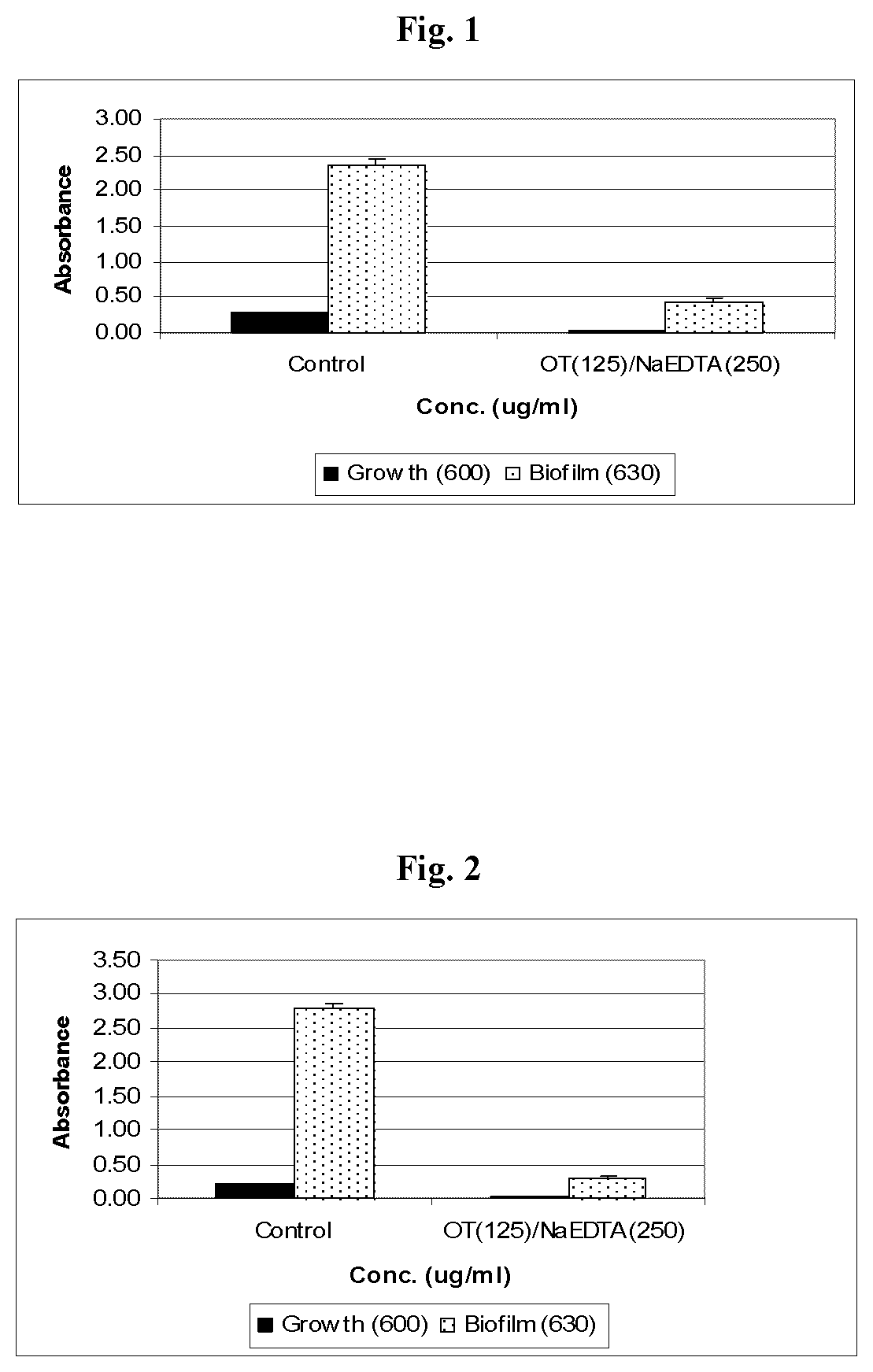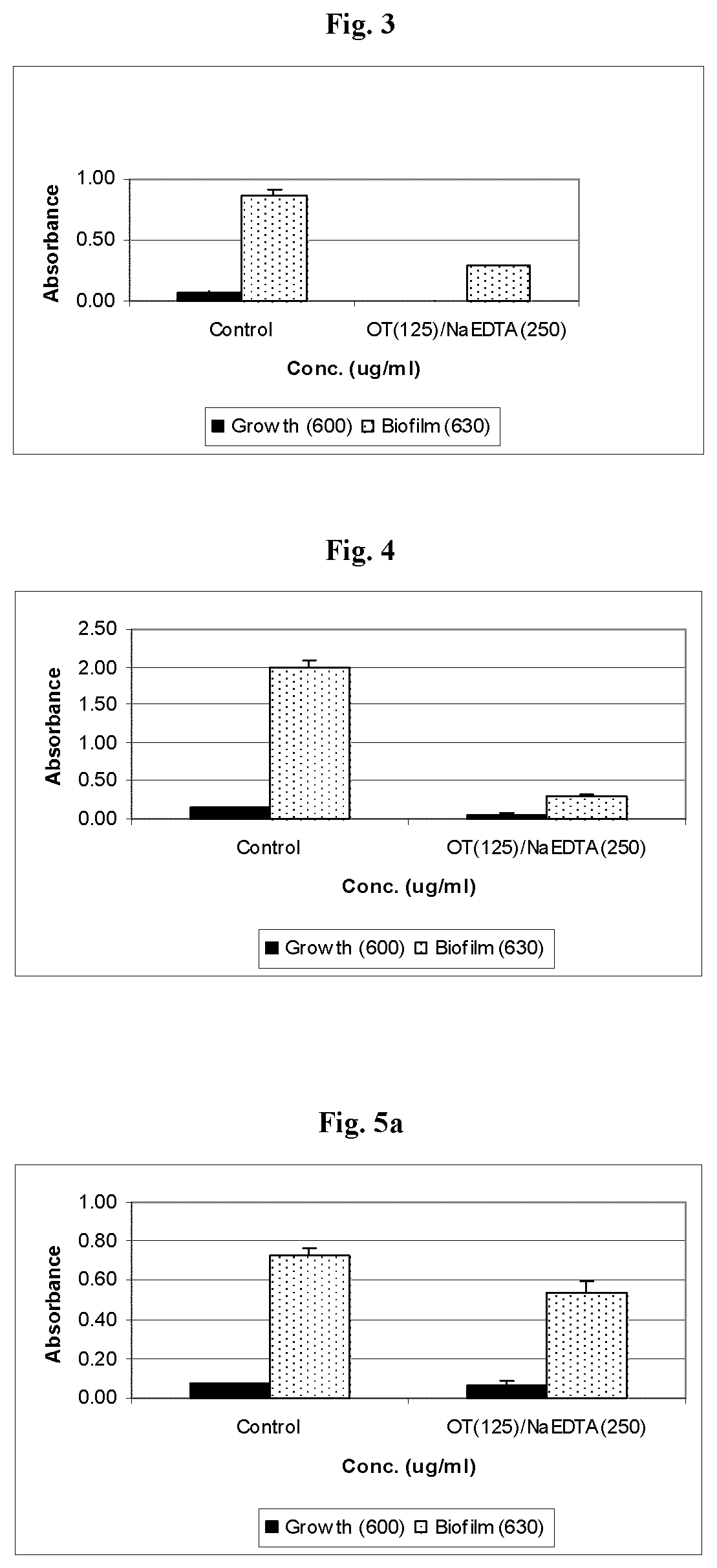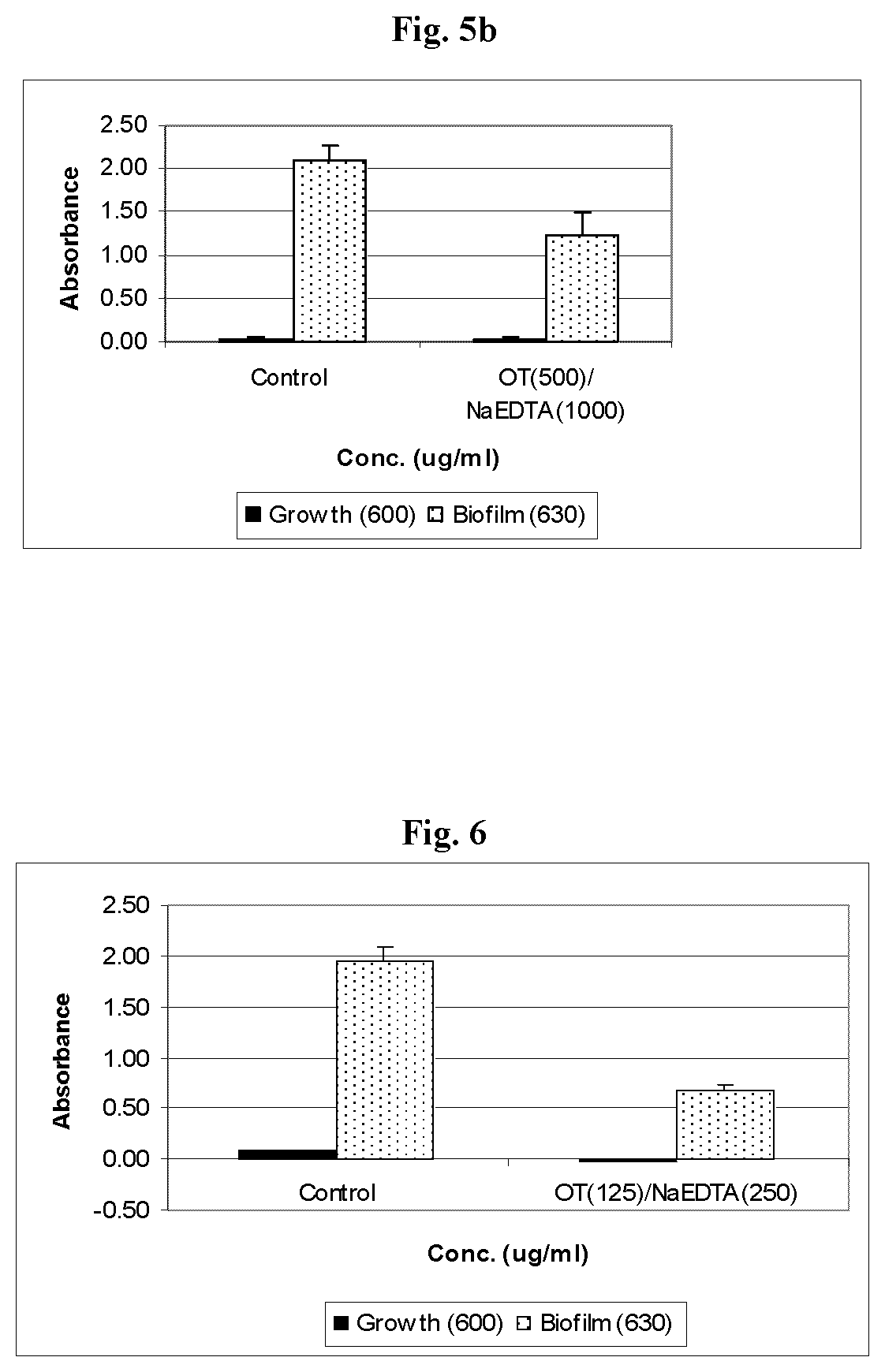Compositions and methods for reducing oral biofilm
a biofilm and composition technology, applied in the direction of antibacterial agents, drug compositions, peptide/protein ingredients, etc., can solve the problems of pain and loss of tooth viability, costly tooth repair or extraction, and difficulty in keeping teeth sufficiently clean, so as to enhance the stability and efficacy of anti-infective compounds
- Summary
- Abstract
- Description
- Claims
- Application Information
AI Technical Summary
Benefits of technology
Problems solved by technology
Method used
Image
Examples
example 1
Inhibitory Effect of Ovotransferrin (OT) and Disodium Ethylenediaminetetraacetic Acid (NaEDTA) Combination on Dental Caries-Associated Biofilms
[0102]A 96-well crystal violet staining biofilm assay was used to determine the inhibitory effect of ovotransferrin (OT) and disodium ethylenediaminetetraacetic acid (NaEDTA) combination on dental caries causing bacteria involved in dental plaque (biofilm) formation. Briefly, stock cultures were grown under anaerobic conditions in Todd Hewitt media containing 0.3% Yeast Extract (THYE), and 0.01% hog gastric mucin, pH 7.0. Biofilms were developed in 96-well Costar 3598 microtiter plates (Corning Inc., Corning, N.Y.). Growth of static biofilms was initiated by inoculation of overnight culture at 3.3% into semi-defined minimal (SDM) media containing salts (58 mM K2HPO4, 15 mM KH2PO4, 10 mM (NH4)2SO4, 35 mM NaCl, and 2 mM MgSO4.7H2O) vitamins (0.04 mM nicotinic acid, 0.1 mM pyridoxine HCl, 0.01 mM pantothenic acid, 1 μM riboflavin, 0.3 μM thiamin...
example 2
Inhibitory Effect of Ovotransferrin (OT) and Disodium Ethylenediaminetetraacetic Acid (NaEDTA) Combination on Gingivitis-Associated Biofilm
[0103]A 96-well crystal violet staining biofilm assay was used to determine the inhibitory effect of ovotransferrin (OT) and disodium ethylenediaminetetraacetic acid (NaEDTA) combination on gingivitis-associated biofilm formation. Briefly, glycerol stocks were grown on Tryptic Soy Agar plates supplemented with 0.025% menadione (5 mg / ml), 0.1% hemin (1 mg / ml) and 5% sheep's blood, for 48 h under anaerobic conditions. Liquid cultures (25 ml) were grown under anaerobic conditions (24 h) in Todd Hewitt media supplemented with 0.1% hemin (1 mg / ml) and 0.025% menadione (5 mg / ml). Biofilms were developed in 96-well Costar 3598 microtiter plates (Corning Inc., Corning, N.Y.). Growth of Porphyromonas gingivalis W50 static biofilms was initiated by inoculation of overnight culture at 1:10 dilution in a modified salt base media containing (10 mM Na2H2PO4, 1...
example 3
Inhibitory Effect of Ovotransferrin (OT) and Disodium Ethylenediaminetetraacetic Acid (NaEDTA) Combination on Periodontitis-Associated Biofilm
[0104]A 96-well crystal violet staining biofilm assay was used to determine the inhibitory effect of ovotransferrin (OT) and disodium ethylenediaminetetraacetic acid (NaEDTA) combination on periodontitis-associated biofilm formation. Briefly, glycerol stocks were grown on Tryptic Soy Agar plates supplemented with 5% sodium bicarbonate for 48 h under anaerobic conditions. Ten colonies of Aggregatibacter actinomycetemcomitans UT32 were removed from these plates and transferred to 200 μl of fresh broth [Tryptic Soy broth (30 g / L), Yeast extract (6 g / L), Dextrose (8 g / L)]. Vortex for 10 s, transfer the 200 μl to 2 ml of fresh broth and vortex for 15 s. The inocula is passed through a 5 μM PVDF syringe filter (Millex-SV Cat. No SLSVO25LS). Biofilms were developed in 96-well Costar 3598 microtiter plates (Corning Inc., Corning, N.Y.). Growth of stat...
PUM
| Property | Measurement | Unit |
|---|---|---|
| concentration | aaaaa | aaaaa |
| concentration | aaaaa | aaaaa |
| concentration | aaaaa | aaaaa |
Abstract
Description
Claims
Application Information
 Login to View More
Login to View More - R&D
- Intellectual Property
- Life Sciences
- Materials
- Tech Scout
- Unparalleled Data Quality
- Higher Quality Content
- 60% Fewer Hallucinations
Browse by: Latest US Patents, China's latest patents, Technical Efficacy Thesaurus, Application Domain, Technology Topic, Popular Technical Reports.
© 2025 PatSnap. All rights reserved.Legal|Privacy policy|Modern Slavery Act Transparency Statement|Sitemap|About US| Contact US: help@patsnap.com



